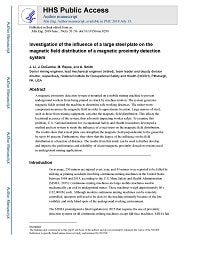Mining Publication: Investigation of the Influence of a Large Steel Plate on the Magnetic Field Distribution of a Magnetic Proximity Detection System
Original creation date: June 2018
Authors: J Li, J Ducarme, M Reyes, A Smith
A magnetic proximity detection system is mounted on a mobile mining machine to prevent underground workers from being pinned or struck by machine motion. The system generates magnetic fields around the machine to determine safe working distances. The miner-worn component measures the magnetic field in order to approximate location. Large masses of steel, such as those from mining equipment, can alter the magnetic field distribution. This affects the locational accuracy of the system, thus adversely impacting worker safety. To examine this problem, U.S. National Institute for Occupational Safety and Health researchers developed a method and test system to study the influence of a steel mass on the magnetic field distribution. The results show that a steel plate can strengthen the magnetic field perpendicular to the generator by up to 40 percent. Furthermore, they show that the degree of the influence on the field distribution is a function of distance. The results from this study can be used to further develop and improve the performance and reliability of electromagnetic proximity detection systems used in underground mining applications.

- Engineering Considerations and Selection Criteria for Proximity Warning Systems for Mining Operations
- Medium-Frequency Propagation in Coal Mines
- Methane-Air Mixtures Ignited by CW Laser-Heated Targets on Optical Fiber Tips: Comparison of Targets, Optical Fibers, and Ignition Delays
- Modeling and Data Analysis of 50 to 5000 kHz Radio Wave Propagation in Coal Mines
- Preliminary Performance Predictions For Electromagnetic Through-The-Earth Mine Communications: A Collection of Working Memoranda
- Preventing Collisions Involving Surface Mining Equipment: A GPS-based Approach
- Recommendations for Evaluating & Implementing Proximity Warning Systems on Surface Mining Equipment
- A Spatial/Spectral Domain Microwave Coal Seam Imaging Sensor-Progress in Signal Processing
- Surface Haulage Truck Research
- Test Results of Collision Warning Systems for Surface Mining Dump Trucks